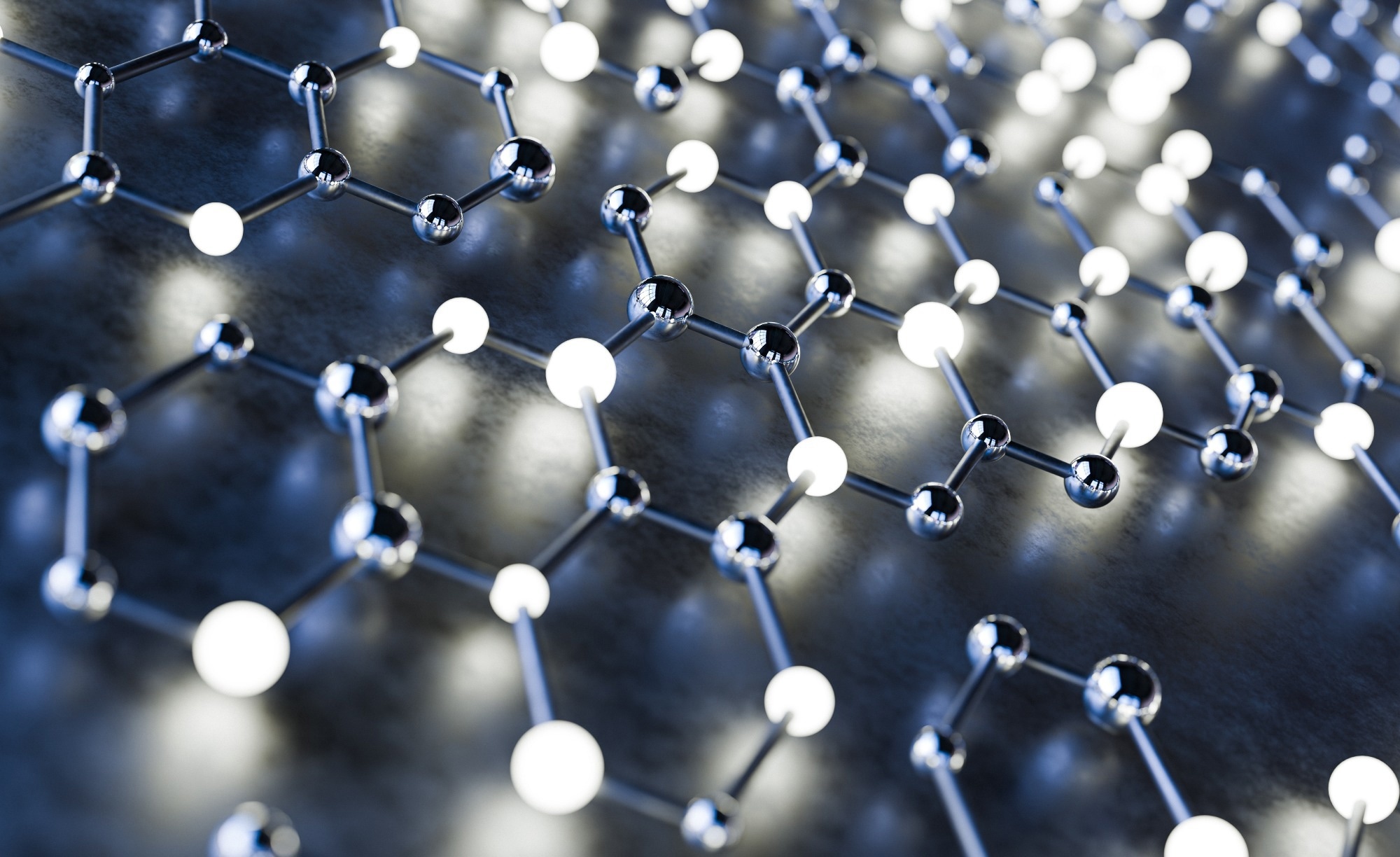 By Akshatha ChandrashekarReviewed by Frances BriggsOct 30 2025
By Akshatha ChandrashekarReviewed by Frances BriggsOct 30 2025A new review reveals how electrically insulating h-BN nanosheets overcome graphene’s corrosion drawbacks and unlock new pathways for durable, next-gen industrial coatings.
 Image Credit: Cleiton_Ilustra/Shutterstock.com
Image Credit: Cleiton_Ilustra/Shutterstock.com
A recent review published in the Journal of Physics: Materials examines the potential of hexagonal boron nitride (h-BN) as an anticorrosion coating material for various applications.
The review highlights h-BN’s unique features, such as chemical inertness, impermeability to ions and moisture, and electrical insulation, which enable long-term corrosion protection compared to conventional coatings.
The authors provide an overview of recent advances in synthesis routes, functionalization techniques, and hybrid composite designs aimed at optimizing h-BN performance. Overall, the review serves as a valuable reference for researchers focused on innovative materials solutions for corrosion protection.
Introduction
Corrosion resistance remains a critical concern across several industries, driving the demand for more durable protective coatings. Traditional organic and metallic coatings fail to remain stable under varying temperature, humidity, and chemical conditions.
Advances in two-dimensional materials present new opportunities to overcome these challenges. Among them, graphene gained attention for its barrier properties, but its high electrical conductivity was found to accelerate galvanic corrosion, especially in defective coatings.
h-BN offers a clear advantage due to its electrical insulation and exceptional chemical stability. This review systematically examines how h-BN nanosheets can be engineered to improve coating technologies through material design and applied performance studies.
It also discusses how h-BN-based coatings resist both chemical and microbial degradation compared to conventional organic coatings. By integrating attributes such as engineered self-healing ability, enhanced hydrophobicity, and long-term environmental durability, h-BN-based coatings offer strong potential for industrial translation and commercialization.
Studies Highlighted in the Review
h-BN materials protect metallic surfaces via the formation of physical barrier mechanism. In one study, defect-free h-BN films were grown by chemical vapor deposition (CVD) on metals such as copper and nickel. These films showed a significant reduction in corrosion rates under oxidative and saline conditions and maintained chemical stability at temperatures up to 1,100?°C.
However, the review notes that most studies of these coatings are short-term, typically spanning hours to a few weeks, and longer-term field performance remains under investigation. This protective barrier effect exceeds that of conventional coatings and of graphene in terms of impermeability.
Several studies examined the incorporation of h-BN nanosheets into polymer matrices, including epoxy and polyisobutylene, to develop composite coatings with enhanced corrosion resistance. The dispersed nanosheets created complex diffusion pathways that effectively restricted ionic transport to the underlying metal. Significant reductions in corrosion current density were observed compared to pristine polymer coatings.
The review also discusses strategies to reduce aggregation and improve dispersion through advanced surface functionalization methods. These include covalent functionalization using silane coupling agents and non-covalent modification with ionic liquids or carbon dots.
In one case, incorporating only 0.5 wt% ionic liquid-functionalized h-BN nanosheets maintained high corrosion resistance even after prolonged salt exposure, confirming enhanced durability and adhesion strength. These chemical modifiers promote uniform coating formation and offer additional benefits, such as crack resistance and improved self-healing.
Recent progress involves combining h-BN with other nanostructures, including graphene oxide and mesoporous silica, to enable active inhibitor release and localized corrosion protection. Collectively, these studies demonstrate the advancement of h-BN-based coatings toward multifunctional, reliable systems with broad industrial applicability.
Get all the details: Grab your PDF here!
Discussion
The review outlines the characteristics and challenges of using h-BN as a multifunctional anticorrosion material. Electrical insulation and thermal stability up to 850?°C provide significant advantages for corrosion protection. However, defects, wrinkles, and grain boundaries introduced during synthesis and transfer processes remain key limitations.
The researchers also emphasized the importance of controlling nanosheet quality, dispersion, and orientation to maximize coating performance.
To address these challenges, the review examined top-down fabrication methods such as wet-jet milling and ball milling, alongside surface functionalization strategies, to improve both the scale of h-BN production and its compatibility with polymers.
Edge-selective techniques were found to enhance durability and integrate desirable functional attributes while preserving h-BN’s structure. h-BN/polymer composite coatings achieve synergistic improvement in corrosion resistance, mechanical strength, crack resistance, and composite-enabled self-healing functionality.
Collaborative industry studies confirmed that h-BN-enhanced coatings maintain resistance during salt spray and seawater immersion, meeting established International Standard Organization (ISO) mechanical and electrochemical benchmarks. Despite ongoing challenges with dispersibility and cost, advances in formulation continue to optimize scalability and economic viability.
Conclusion
This review provides a comprehensive evaluation of h-BN as anticorrosion coatings for a multitude of industrial applications. By addressing both fundamental mechanisms and practical challenges, the authors illustrate how h-BN’s chemical, thermal, and electrochemical properties make it a promising alternative to conventional materials.
Recent advances in synthesis and functionalization enable precise control over nanosheet properties and scalable production, enabling the development of defect-free, large-area coatings. However, many performance studies remain limited to short durations, and further research is needed to assess long-term durability under real-world conditions.
Future research should focus on optimizing scalable, cost-effective synthesis methods to produce large-area, defect-free h-BN nanosheets with controlled thickness and crystallinity. It should also prioritize standardizing direct growth and transfer processes for h-BN films onto complex substrates, with emphasis on minimizing structural defects.
Additionally, ensuring stable, long-term dispersion in polymer matrices will be key to performance reliability in composite coatings. Together, these advancements position h-BN as a promising material platform for reliable and environmentally responsible anticorrosion technologies.
Journal Reference
Kaya, O., et al. (2025). 2D hexagonal boron nitride-based anticorrosion coatings. Journal of Physics: Materials, 8(4), 042002. DOI: 10.1088/2515-7639/AE0F53.
Disclaimer: The views expressed here are those of the author expressed in their private capacity and do not necessarily represent the views of AZoM.com Limited T/A AZoNetwork the owner and operator of this website. This disclaimer forms part of the Terms and conditions of use of this website.